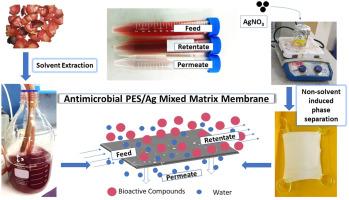聚醚砜(PES)超滤膜富集山竹皮提取物中银颗粒的原位生长
IF 3.9
3区 工程技术
Q3 ENERGY & FUELS
Chemical Engineering and Processing - Process Intensification
Pub Date : 2025-09-12
DOI:10.1016/j.cep.2025.110555
引用次数: 0
摘要
山竹果皮通常作为固体废物丢弃,它含有有益于公众健康的生物活性化合物。商用膜可以浓缩这些化合物以增强储存和运输,但长时间过滤富含有机物的溶液会导致生物污染。作为工艺创新,在聚醚砜(PES)超滤基质中原位生长银(Ag)颗粒,制备了混合基质抗菌膜。Ag颗粒均匀分布在膜表面,横截面EDX图显示Ag - pvp配合物在亲水性驱动下,在相转化过程中向水界面迁移。聚乙烯吡咯烷酮(PVP)作为还原、分散和封盖剂的三重作用得到了强调,PVP中的N和O原子与Ag +离子形成配位键。以0.1 wt% Ag为前驱体的膜过滤山竹皮提取物2 h后,通量最高(15.52 L/m²·h·bar),浓缩效率最高(13.80%),能耗最低(0.3560 W·h/L)。总酚类化合物的截留率为81.78 ~ 89.28%,而总单体花青素的截留率较低(29.48 ~ 58.70%),表明PES/Ag膜具有分离两种化合物的潜力。圆盘扩散试验证实,1.0 wt% AgNO₃膜对金黄色葡萄球菌和大肠杆菌具有抗菌性,抑制环直径分别为0.6 mm和0.7 mm。综上所述,PES/Ag膜可以有效地浓缩酚类化合物,提高抗生物污染能力,未来的工作重点是优化Ag的合成和评估颗粒浸出。本文章由计算机程序翻译,如有差异,请以英文原文为准。

In-situ growth of silver particles in polyethersulfone (PES) ultrafiltration membrane for concentrating mangosteen rind extract
Mangosteen rind, often discarded as solid waste, contains bioactive compounds beneficial to public health. Commercial membranes can concentrate these compounds to enhance storage and transport, but prolonged filtration of organic-rich solutions causes biofouling. As process innovation, a mixed-matrix antibacterial membrane was developed by in-situ growth of silver (Ag) particles in a polyethersulfone (PES) ultrafiltration matrix. Ag particles were uniformly distributed on the membrane surface, with cross-sectional EDX mapping showing migration of Ag–PVP complexes to the water interface during phase inversion, driven by hydrophilicity. The triple role of polyvinylpyrrolidone (PVP) as reducing, dispersing, and capping agent was highlighted, with N and O atoms in PVP forming coordinate bonds with Ag⁺ ions. The membrane with 0.1 wt% Ag precursor achieved the highest flux (15.52 L/m²·h·bar) and concentration efficiency (13.80 %), and lowest energy use (0.3560 W·h/L) after two hours of filtering the mangosteen rind extract. Total phenolic content rejection was 81.78–89.28 %, while total monomeric anthocyanin rejection was lower (29.48–58.70 %), indicating the PES/Ag membrane’s potential for fractionating both compounds. Disk diffusion tests confirmed antibacterial resistance of the 1.0 wt% AgNO₃ membrane against Staphylococcus aureus and Escherichia coli with inhibition ring diameters of 0.6 mm and 0.7 mm, respectively. In conclusion, the PES/Ag membrane effectively concentrated phenolic compounds and improved biofouling resistance, with future work focusing on optimizing Ag synthesis and assessing particle leaching.
求助全文
通过发布文献求助,成功后即可免费获取论文全文。
去求助
来源期刊
CiteScore
7.80
自引率
9.30%
发文量
408
审稿时长
49 days
期刊介绍:
Chemical Engineering and Processing: Process Intensification is intended for practicing researchers in industry and academia, working in the field of Process Engineering and related to the subject of Process Intensification.Articles published in the Journal demonstrate how novel discoveries, developments and theories in the field of Process Engineering and in particular Process Intensification may be used for analysis and design of innovative equipment and processing methods with substantially improved sustainability, efficiency and environmental performance.

 求助内容:
求助内容: 应助结果提醒方式:
应助结果提醒方式:


